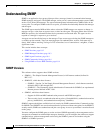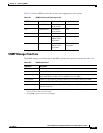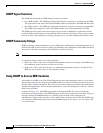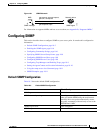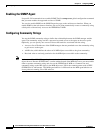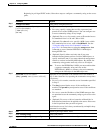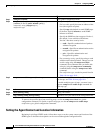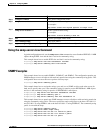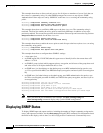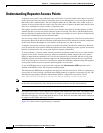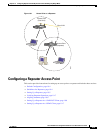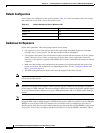
18-9
Cisco IOS Software Configuration Guide for Cisco Aironet Access Points
OL-30644-01
Chapter 18 Configuring SNMP
Configuring SNMP
Access points running this Cisco IOS release can have an unlimited number of trap managers.
Community strings can be any length.
Table 18-4 describes the supported access point traps (notification types). You can enable any or all of
these traps and configure a trap manager to receive them.
Some notification types cannot be controlled with the snmp-server enable global configuration
command, such as udp-port. These notification types are always enabled. You can use the snmp-server
host global configuration command to a specific host to receive the notification types listed in
Table 18-4.
Beginning in privileged EXEC mode, follow these steps to configure the access point to send traps to a
host:
Table 18-4 Notification Types
Notification Type Description
aaa_server Enable traps for AAA events
authenticate-fail Enable traps for authentication failures.
config Enable traps for SNMP configuration changes.
deauthenticate Enable traps for client device deauthentications.
disassociate Enable traps for client device disassociations.
dot11-qos Enable traps for QoS changes.
entity Enable traps for SNMP entity changes.
rogue-ap Enable traps for rogue access point detections.
snmp Enable traps for SNMP events.
switch-over Enable traps for switch-overs.
syslog Enable syslog traps.
wlan-wep Enable WEP traps.
cef Allows cef traps
config-copy Allow SNMP config-copy traps
config-ctid Allow SNMP config-ctid traps
cpu Allow cpu related traps
dot11-mibs Allow dot11 traps
entity Allow SNMP entity traps
l2tun-pseudowire-status Allow SNMP L2 pseudowire status traps
l2tun-session Allow SNMP L2 session traps
syslog Allow SNMP syslog traps
tty Allow TCP connection traps
udp-port The notification host's UDP port number
vrfmib Allow SNMP vrfmib traps




